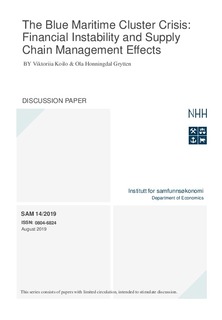The Blue Maritime Cluster Crisis: Financial Instability and Supply Chain Management Effects
Working paper

Åpne
Permanent lenke
http://hdl.handle.net/11250/2607950Utgivelsesdato
2019-08Metadata
Vis full innførselSamlinger
- Discussion papers (SAM) [657]
Sammendrag
The present paper investigates the offshore crisis 2015-2017 and its impact on one of the most complete maritime clusters, more precise the Blue Maritime Cluster, located at Møre og Romsdal at the North Western Coast of Norway.
As this cluster is heavily involved in offshore petroleum operations, it experienced an almost devastating blow during the crisis. The cluster lost almost one third of its employees as its value added contracted by 39 percent.
The crises is basically seen as result of the falling oil prices and, thus, lower activity and squeezed profit margins, particularly in marginal oil and gas fields. The paper does not dispute this. However, it also investigates the crisis in the light of financial instability and chain reactions down the maritime supply chain.
By collecting data from the Blue Maritime Cluster and the Norwegian central company register one is able, both to trace the fall in activity due to the crisis and measures of financial strength. The study approaches the data by using structural time series analysis in order to map cycles as deviations from polynomial trends.
The conclusions are that financial instability was dominant within the Blue Maritime Cluster during its boom before the crisis. Debt ratios, and thereby gearing or leverage was high. Thus, the companies could not meet their obligations when the crisis hit, due to low solidity and loss of financial stability.
The paper also finds that narrow focused supply chain management, made the cluster fall deep in to the abyss when ship owning companies and shipyards were hit. Companies with a more diversified portfolio were able to meet the hard years better than others.